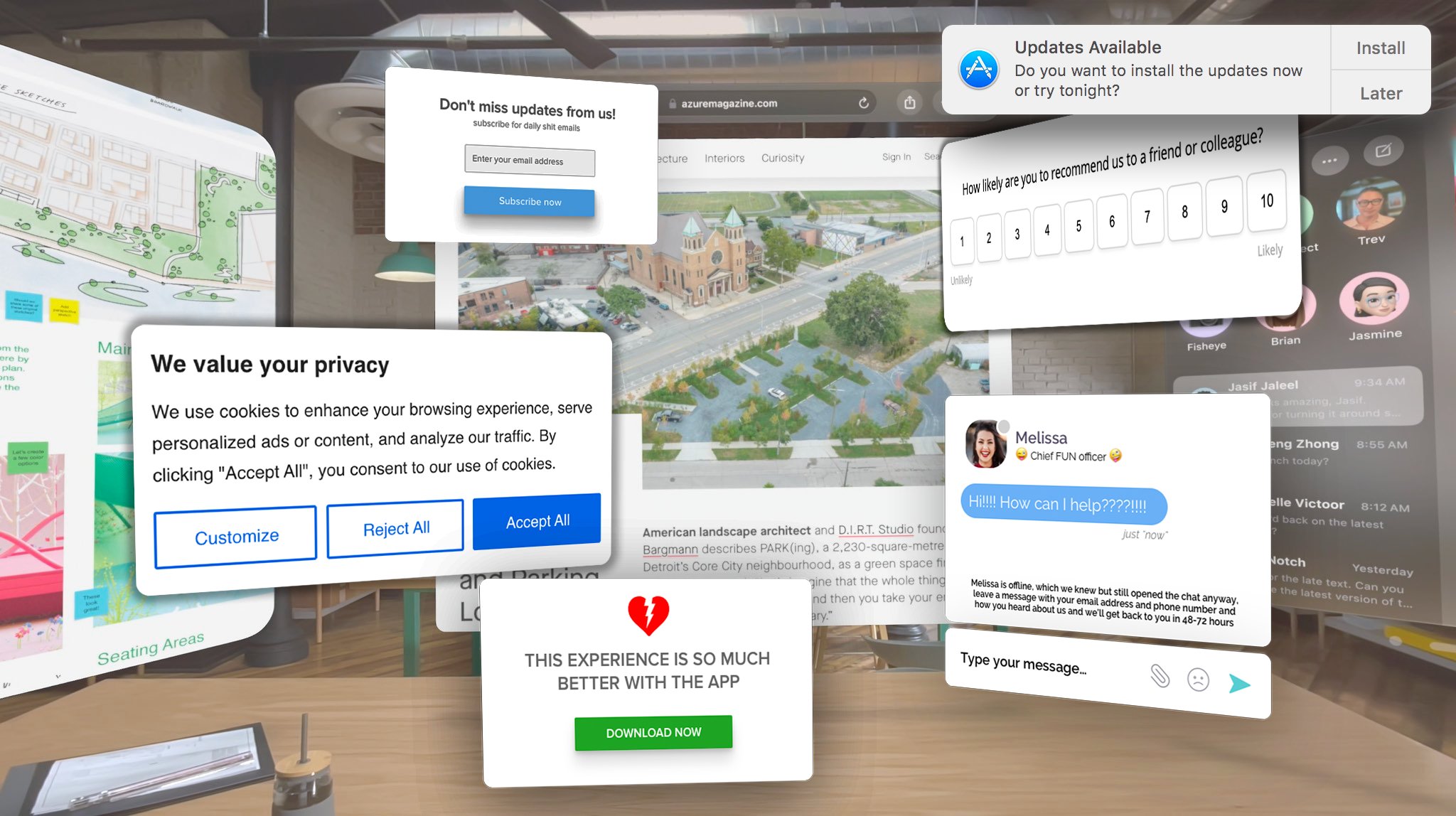SCENE: MIDMARKET RESTAURANT – AFTERNOON Doorman: (Opens door) “Good afternoon Madam, Sir.” Maître d: (Enthusiastically) “Mr and Mrs Turnbull. So nice to see you again. How are those mischievous children of yours? Would you care for your usual table? Of course, right this way…” FADE
Nice welcome, right? How does that compare to the online experience of the very same restaurant however? It might go something like this:
SCENE: MIDMARKET RESTAURANT WEBSITE – 3AM Customer: (Walks into website) “Hello, I’d like to…” Interstitial banner: (Jumps in front of the customer, shouting) “SIGN UP TO OUR NEWSLETTER!” Customer: (Searching for close button) “No thanks, I’m already signed up actually.” Cookie banner: (Blocks entrance to restaurant) “Do you give your permission to record your entire visit and all future visits on any medium of our choice and sell that data to any company we choose in future?” Customer: (Pushing past the banner, annoyed) “I actually just want to book a table?” Booking form: “Which location are you interested in?” Customer: (Sighing) “The one I always go to.” Booking form: “If you’ve visited us before, please use the previous visitors booking form, over there, otherwise please tell me your name.” Customer: “Actually, never mind.” (closes browser tab) FADE
This one… not so welcoming. Sadly this situation isn’t in the slightest bit unusual, but what went wrong? Clearly there was no recognition of the customer at all, and they were treated (as we all so often are online), as a completely new customer with no connection or shared history whatsoever with the brand or their website.
How can this be though? Surely GDPR dramas, cookie crackdowns, data breaches and password leaks have taught us all that our online data is readily available to anyone who cares to look for it, and that all of our personal information is constantly being mined by superpowered Artificial Intelligences that use it to target us with irresistible offers that cause us to tumble endlessly within a repeating spin-cycle of mindless consumerism!
(Woah, dude… that got heavy).
Some of that may be true of course. But the day-to-day reality is that many brands are only engaging with the most basic of the available customer data, and due to the crude tools they must employ and a lack of cogent thinking, they are inadvertently developing actively-hostile user experiences for their current and potential future customers.
I hope that the first thing they teach at marketing university is that rewarding your customers is going to lead to increased sales. There’s a neurological reward system literally (and I do mean literally) built into our brains that directly affects our decision-making abilities through learning procedures such as positive reinforcement (a process whereby animals, including us, learn that a good thing happened when they did something in the past, therefore a good thing is likely to happen if they do it again).
Neuroscience aside, at a more human level – we all like to believe we’re getting a good deal – and reward schemes, loyalty points and discounts all help to give us the extra reassurance we need. Which is why these benefits are so prevalent across the whole of the retail and online markets.
“69% of consumers say choice of retailer is influenced by where they can earn customer loyalty/rewards program points”
However I’m not here to tell you how to reward your customers (you learned that in marketing 101, right?) Of course you should give customers points for their purchases, exclusive deals, birthday gifts, member benefits and discounts. Of course you should provide additional value for repeat customers – but remember that it’s OK to gather user data and to use it to make customers’ experiences better! You just have to know who they are before you start blindly throwing your marketing arsenal at them.
“Loyal customers buy 30% more items per order compared to a first-time customer”
Going back to the restaurant scene at the start of this article, the problem was a lack of recognition. You need to know who you’re talking to so that you can be welcoming, and you need to know what that person wants so that you can reward them properly.
Get your users logged in, and keep them logged in. Convince them to log in on every device they own. Don’t log them out unless you have to. Position the experience of being logged in to your site as being so much better than being logged out that your users won’t be able to resist. Once you have someone hooked into your system to that level, then you can truly start the process of actually learning who they are, how they think, and how you can use their purchases, preferences, history and behaviours effectively, allowing you to provide personalised, welcoming and rewarding experiences that keep them coming back time and time again.
I’m not saying it’s going to be easy – it took Amazon a very long time to become the default shopping platform in the UK – but this is how they did it, and maybe it will work for you too.
